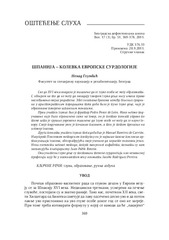Приказ основних података о документу
Spain: The cradle of European surdology
Španija - kolevka evropske surdologije
| dc.creator | Glumbić, Nenad | |
| dc.date.accessioned | 2021-06-09T13:38:53Z | |
| dc.date.available | 2021-06-09T13:38:53Z | |
| dc.date.issued | 2011 | |
| dc.identifier.issn | 0354-8759 | |
| dc.identifier.uri | http://rfasper.fasper.bg.ac.rs/handle/123456789/445 | |
| dc.description.abstract | Up to XVI century it was generally believed that deaf people were uneducable. Since they could not learn to speak they should not legally inherit possessions of their parents. There were many deaf children in aristocratic families of that time, due to consanguineous marriages and they were entrusted to the care of Spanish monks who undertook the teaching of deaf children. The first teacher of the deaf was fray Pedro Ponce de León. Although his teaching was not limited to speech alone, he became famous by challenging the conventional wisdom that deaf people could not learn to speak. He began his work by teaching deaf students to write and than proceeded to pronunciation. The second famous teacher of the deaf of that time was Manuel Ramírez de Carrión. Contrary to Ponce's method his students were primarily thought pronunciation and they were discouraged to use sign language. Some elements of his teaching methods, especially manual alphabet, were revealed in public thanks to plagiarism of Juan Pablo Bonet. These teachers set strong foundation for establishing surdology as an independent profession in XVIII century, by Jacobo Rodríguez Pereira. | en |
| dc.description.abstract | Sve do XVI veka vladalo je mišljenje da se gluve osoba ne mogu obrazovati. S obzirom na to da ne mogu da ovladaju govorom gluva deca nisu imala pravo nasleđivanja svojih roditelja. Zbog sklapanja brakova između bliskih srodnika u aristokratskim porodicama toga doba bilo je puno gluve dece, čije je obrazovanje povereno španskim monasima. Prvi učitelj gluvih bio je fratar Pedro Ponce de León. Iako njegovo podučavanje nije bilo ograničeno samo na govor, on je postao poznat upravo po tome što je srušio uvreženo mišljenje da gluve osobe ne mogu da se nauče govoru. Svoje podučavanje uvek je počinjao pisanjem, a tek je potom prelazio na izgovor glasova. Drugi poznati učitelj gluvih toga doba bio je Manuel Ramírez de Carrión. Nasuprot Ponseovom metodskom postupku on je najviše pažnje poklonio artikulaciji glasova, obeshrabrujući svoje učenike da koriste znakovni jezik. Neki elementi njegovog metoda, poput manuelnog alfabeta, poznati su nam zahvaljujući plagijarizmu Juan Pablo Boneta. Ovi učitelji gluve dece su postavili temelje surdologiji kao nezavisnoj profesiji koju će u osamnaestom veku osnovati Jacobo Rodríguez Pereira. | sr |
| dc.publisher | Univerzitet u Beogradu - Fakultet za specijalnu edukaciju i rehabilitaciju, Beograd | |
| dc.publisher | Društvo defektologa Srbije | |
| dc.rights | openAccess | |
| dc.rights.uri | https://creativecommons.org/licenses/by-sa/4.0/ | |
| dc.source | Beogradska defektološka škola | |
| dc.subject | deaf | en |
| dc.subject | education | en |
| dc.subject | manual alphabet | en |
| dc.subject | gluvi | sr |
| dc.subject | obrazovanje | sr |
| dc.subject | ručna azbuka | sr |
| dc.title | Spain: The cradle of European surdology | en |
| dc.title | Španija - kolevka evropske surdologije | sr |
| dc.type | article | |
| dc.rights.license | BY-SA | |
| dc.citation.epage | 378 | |
| dc.citation.issue | 3 | |
| dc.citation.other | (3): 369-378 | |
| dc.citation.rank | M52 | |
| dc.citation.spage | 369 | |
| dc.identifier.fulltext | http://rfasper.fasper.bg.ac.rs/bitstream/id/438/442.pdf | |
| dc.identifier.rcub | https://hdl.handle.net/21.15107/rcub_rfasper_445 | |
| dc.type.version | publishedVersion |


